Blue Whale Watching in Sri Lanka
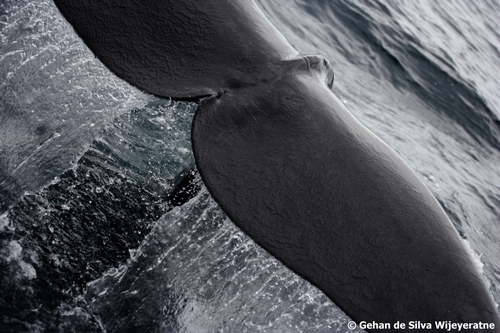
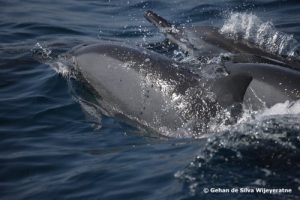
Welcome to the most comprehensive site on whale watching and dolphin watching in Sri Lanka.
In May 2008, Gehan de Silva Wijeyeratne broke the story that Southern Sri Lanka is the best place in the world for seeing Blue Whales. The links below contain some of the articles, press publicity, real accounts and the most detailed log of sightings available.
SRI LANKA – BEST FOR BLUE
Almost everyone in the world, dreams of seeing a Blue Whale. With Blue Whales we have now established that during the season (From November – April each year) the strike rate is over ninety per cent, off Mirissa. Nowhere else in the world can Blue Whales be seen in such numbers and with such ease.
What is more, the South of Sri Lanka is the best place in the world for seeing both Blue Whales and Sperm whales in one whale watching trip. To have been a good site for either the largest baleen whale or for the largest toothed whale would have been good. To be one of the top locations in the world for both is remarkable. For Sperm Whales, between Mirissa and Kalpitiya, the strike rate is good enough for marine wildlife tourism where visitors engage in multiple visits to sea. I believe Kalpitiya is the place in which to focus the search for Sperm Whales, based on the data during the first quarter of 2010.
Awareness that Sri Lanka is the top spot in the world for seeing and photographing Blue Whales began with a press blitz I began in May 2008. This hinged on the Anderson hypothesis that the Blue Whales undertook an East-West migration between the Arabian Sea off the Horn of Africa and the Bay of Bengal. I have likened it to a U –shaped migration. However, on a global scale it can be viewed as a horizontal movement or if at all as one with a very shallow U shape as the whales curve around the South of Sri Lanka. The migration is driven by the seasonal presence of food: the krill upon which the Blue Whales feed, typically in the top 60 meters of water, but they could be feeding down to 300-400m. The strong winds of the South-west Monsoon physically displace water away from the African coast. Water must well up from below to replace the water which has been pushed away. The up-welling created, brings up nutrients which lead to a blooming of phytoplankton which are in turn fed on by zooplankton such as krill and creates a food chain for other marine animals. The Blue Whales return to feed on this seasonal blooming of krill. Similarly, their journey to the Bay of Bengal would have been triggered by a seasonal blooming of krill which would have been triggered by upwellings created by the North-east Monsoon. In other words, the Blue Whales go to the areas where the seasonally changing monsoon currents produce seasonally changing plankton bloom areas where the South-west or North-east Monsoon has abated from.
Blue whales seem to be found most commonly along the continental slope, where the relatively shallow inshore waters of the continental shelf drop away steeply to the ocean depths. It is along this slope that local upwellings may occur and where plankton are often concentrated. Where the continental shelf comes close to shore, it may also allow the whales to come closer to the nutrient flow from a land mass which will create a food chain close to shore. In Western Scotland, currents creating nutrient flows and food chains resulted in massive fish stocks close to shore, which led to a large fishing industry.
We have a similar situation off the Kalpitiya Peninusla where it seems currents, nutrient flows and the proximity of the continental shelf has created a large Yellow-fin Tuna fishery close to shore. Where there are fish, there is a food chain. We can therefore also find whales, whether they are baleen whales or toothed whales, feeding in their niche in the food chain, close to shore in Sri Lanka off Mirissa, the Kalpitiya Peninsula and Trincomalee. It is also my personal belief that deep water offer whales a higher degree of maneuverability when facing predators. So the plankton rich deep waters close to the Sri Lankan shore provide both food and safety.
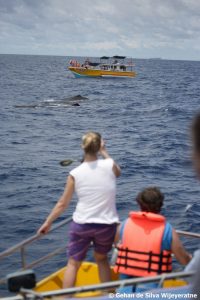
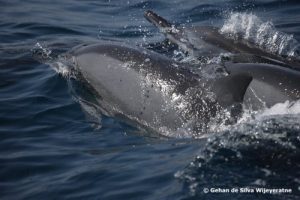
Mirissa
The seas South of Dondra Head are the best for whale and dolphin watching in Sri Lanka. This is because the continental shelf is narrowest around Sri Lanka to the South of Dondra (the southernmost point in Sri Lanka). The whale watching infrastructure is also at its best here.
Depths of one kilometre and deeper are found relatively close to the South of Dondra, approximately six kilometres or 40 minutes away. This may be the reason why both Blue Whales and Sperm Whales can be seen within sight of shore. Sperm Whales dive to depths of one kilometre or more to feed on animals such as squid which live in submarine canyons. As deep water is found close to Dondra Head, it is more likely that Sperm Whales will stray close to shore. Blue Whales feed on krill found within the first 30 meters of depth. But they will use deeper water when travelling. The depths and availability of food to the South of Dondra Head seem to create conditions favourable for seeing both species close to shore. Elsewhere in Sri Lanka (except Kalpitiya and Trincomalee) the continental shelf is further out and therefore whale watchers may have to travel five or six times that distance to reach the one kilometre depth contour.
The continental shelf is defined as the depth contour or isobar of 200m. The location of the continental shelf is important as the depth of water rapidly reaches a depth of one and then two kilometres or deeper beyond this.
Kalpitiya Peninsula
The seas of Kalpitiya Peninsula became known for its large pods of Spinner Dolphins from around 2008, thanks to Dallas Martensyn and his co-investors who developed Alankuda Beach (www.alankuda.com). But everyone stayed within an area bounded by a reef, where the ‘dolphin line’ was found. No one made a concerted effort to travel off-shore of the reef to look for whales for developing commercial whale watching until I set out in March 2010, inspired by Dr Charles Anderson who thought the continental shelf may be closer than shown by published marine maps. I have found Sperm Whales traveling on a North-South Axis along the 400m depth contour (E79 35). This is their typical feeding depth. With my team I also photographed a Blue Whale and rare pelagic seabirds before the window for marine exploration closed in May 2010. However, after I ran the story in March 2010, a few others also ventured offshore of the reef and reported whales. Of a small handful of recent sightings of Orca off Sri Lanka, almost all of them have been from Kalpitiya.
Trincomalee
Trincomalee has been known for a long time for its Blue Whales. Whales come very close to shore because of a submarine canyon which comes into one of the deepest natural harbours in the world. In March 2010, the first post war effort (led by John Keells Hotels) to explore Trincomalee for commercial whale watching were explored. Most of the Blue Whales here may be those passing the South coast, it remains to be seen whether Trincomalee will offer better viewing than from sailings off Mirssa
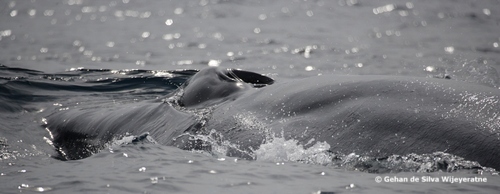
What is the best location for whale watching off Sri Lanka?
For a broad variety of species and a ninety percent chance of seeing a Blue Whale, Mirrisa remains the best option. Also the infrastructure for whale watching is best developed here. From Kalpitiya, the whale watching is done from 18 footer speed boats. The frequency of sightings is less, but there is a greater sense of adventure. Trincomalee in the East coast between the months of February to April also seems to offer reliable sightings of Blue Whales and infrequent sightings of Sperm Whales, but more data needs to be gathered to work out the strike rates.










